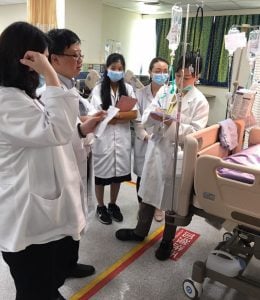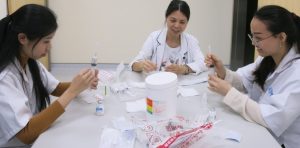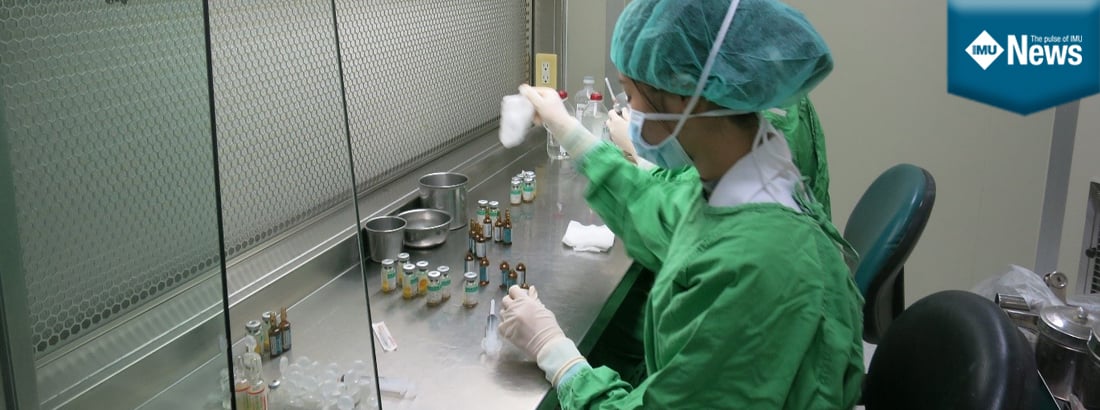During Year 3 of our Bachelor of Pharmacy programme at IMU, we were very lucky to have the opportunity to conduct our electives in Taichung, Taiwan from 15 April 2019 to 19 May 2019. The clinical pharmacy attachment was in Tung’s Taichung Metro Harbor Hospital, a regional teaching hospital which has two campuses located at Shalu District, and Wuqi District respectively. Our attachment was mainly carried out at the hospital’s main campus in Wuqi District. We were both very excited about this elective with the learning objectives of understanding the differences in the healthcare systems in Malaysia and Taiwan, understanding the roles of the pharmacist in a hospital setting and learning how to counsel patients in Mandarin. During our attachment, we were assigned to different pharmacy departments each week: Outpatient Department, Inpatient Department, Drug Information Centre, Clinical Pharmacy Department, and Total Parenteral Nutrient Department. We are very appreciative of the arrangements made, especially in allowing us to take part and experience every activity that was carried out by the pharmacist on duty. This allows us to understand and experience the role of the pharmacist in each department. Before we were assigned to the different departments, there was a sharing session where the senior pharmacist introduced us to the healthcare system in Taiwan, giving us the opportunity to compare and understand the differences in the healthcare systems in Malaysia and Taiwan.
| Week |
Department |
Activities |
| First Week |
Outpatient Department and Drug Information Centre |
We were assigned to the . In the Outpatient Department, we were trained to dispense medications under the supervision of a senior pharmacist on duty. We had also participated in several other activities including packing the medicine, checking the prescription and medications dispensing. We were also given the opportunity to handle, pack and record high alert medicines such as fentanyl patches, morphine injections, and others. Whenever there was some free time, the pharmacist at the Drug Information Centre will educate us about drug counselling. We had the opportunity to sit in and listen during patient counselling and luckily, also had this opportunity to join in for warfarin and insulin counselling with three patients during the week. We learned a lot from the pharmacist’s counselling skills. Since Taiwan is a Mandarin-speaking country, we had to learn how to communicate and interact with a patient in Mandarin throughout the process. The senior pharmacist also brought us to Shalu campus, where they offer methadone replacement therapy to the public. |
| Second Week |
Inpatient Department |
The Inpatient Department is where the pharmacist prepares medications for the hospitalised patients. Tungs’ Hospital distributes medications via complete floor stock system, and we were trained to do every role, including recording, packing, stocking and restocking the medications. This familiarised us with the procedures of the Inpatient Department. In this department, there is also drug counselling sessions where we managed to learn from the senior pharmacist about counselling several patients who started taking warfarin after a heart surgery. |
| Third and Fourth Weeks |
Clinical Pharmacy Department |
The third and fourth week saw us being exposed to real ICU cases. Classes were also scheduled specifically for us on topics such as how to evaluate and report an adverse drug reaction, therapeutic drug monitoring (TDM), prescription screening, SOAP formula to make any report in the computer system, drug use evaluation and evidence-based medicine. We were allowed to access to the ICU patients’ details through the computer system before the ICU tour with a clinical pharmacist and other healthcare professionals including physicians, nurse, and dietitian.  During the ward round, the healthcare professionals will discuss the conditions of each ICU patient. In addition, we were also brought to observe a non-surgical procedure called percutaneous transluminal coronary angioplasty (PTCA) or balloon angioplasty for patients with coronary artery diseases to relief angina attack. The physicians showed us the image of an X-ray of the arteries and explained how PTCA works to save the life of the patients. Besides, we were given a chance to attend a patient care meeting carried out among a few healthcare professionals such as physicians, nurses, dieticians, clinical pharmacist, social worker and patients’ family members regarding a case of premature twins with one having respiratory distress syndrome and patent ductus arteriosus (PDA). During the meeting, important information was delivered to the patients’ family members. The physician explained the current condition of the patients, things to pay attention to while taking care of premature infants and follow-up sessions for both the infants. The clinical pharmacist explained the use of drugs to the patients in ICU, dieticians explained about the nutrition required by pre-mature infants while the social worker explained about the welfare provided by the government for premature infants. During the ward round, the healthcare professionals will discuss the conditions of each ICU patient. In addition, we were also brought to observe a non-surgical procedure called percutaneous transluminal coronary angioplasty (PTCA) or balloon angioplasty for patients with coronary artery diseases to relief angina attack. The physicians showed us the image of an X-ray of the arteries and explained how PTCA works to save the life of the patients. Besides, we were given a chance to attend a patient care meeting carried out among a few healthcare professionals such as physicians, nurses, dieticians, clinical pharmacist, social worker and patients’ family members regarding a case of premature twins with one having respiratory distress syndrome and patent ductus arteriosus (PDA). During the meeting, important information was delivered to the patients’ family members. The physician explained the current condition of the patients, things to pay attention to while taking care of premature infants and follow-up sessions for both the infants. The clinical pharmacist explained the use of drugs to the patients in ICU, dieticians explained about the nutrition required by pre-mature infants while the social worker explained about the welfare provided by the government for premature infants. |
| Fifth Week |
Total Parenteral Nutrition (TPN) and Chemotherapy Drugs Preparation Room |
Due to safety reasons, we were taught a basic technique in using syringe and needle by an experienced pharmacist and both of us were given time to practice the skills of withdrawing, adding and diluting medication in the vials, supervised by the pharmacist.  We were also given the opportunity to handle and prepare a TPN solution for patients in the ward and do cytotoxic drug reconstitution (CDR). Simple preparatory work for example dilution and addition of the multivitamin and trace element into every TPN bag was done. The attire in doing CDR focused more on the safety of the pharmacist hence full personal protective equipment such as N95 mask, double gloves and coated gown which is waterproof is worn before entering the preparatory room to minimise the risk of occupational exposure to hazardous drugs. We were also given the opportunity to handle and prepare a TPN solution for patients in the ward and do cytotoxic drug reconstitution (CDR). Simple preparatory work for example dilution and addition of the multivitamin and trace element into every TPN bag was done. The attire in doing CDR focused more on the safety of the pharmacist hence full personal protective equipment such as N95 mask, double gloves and coated gown which is waterproof is worn before entering the preparatory room to minimise the risk of occupational exposure to hazardous drugs. |
Other than the 5 departments where we gained new knowledge throughout the 5 weeks, we also attended some other activities according to the scheduled timetable, together with the pharmacists in the hospital such as presentation of new drugs by a business representative from pharmaceutical company and talks given by physicians on topics such as antibiotic use in the hospital, pneumonia, skin and soft tissues infections. We also observe some training process scheduled to young pharmacists working in the hospital such as a presentation on antifungal use and OSCE examination.
Overall, both of us think that it was a fruitful learning process in Tungs’ Taichung Metro Harbor Hospital as we have gained insight on the role of a pharmacist in a hospital setting and we were able to achieve all the learning objectives planned.
Written by Tew Xin Nee and Tan Jing Ning [BP116]











